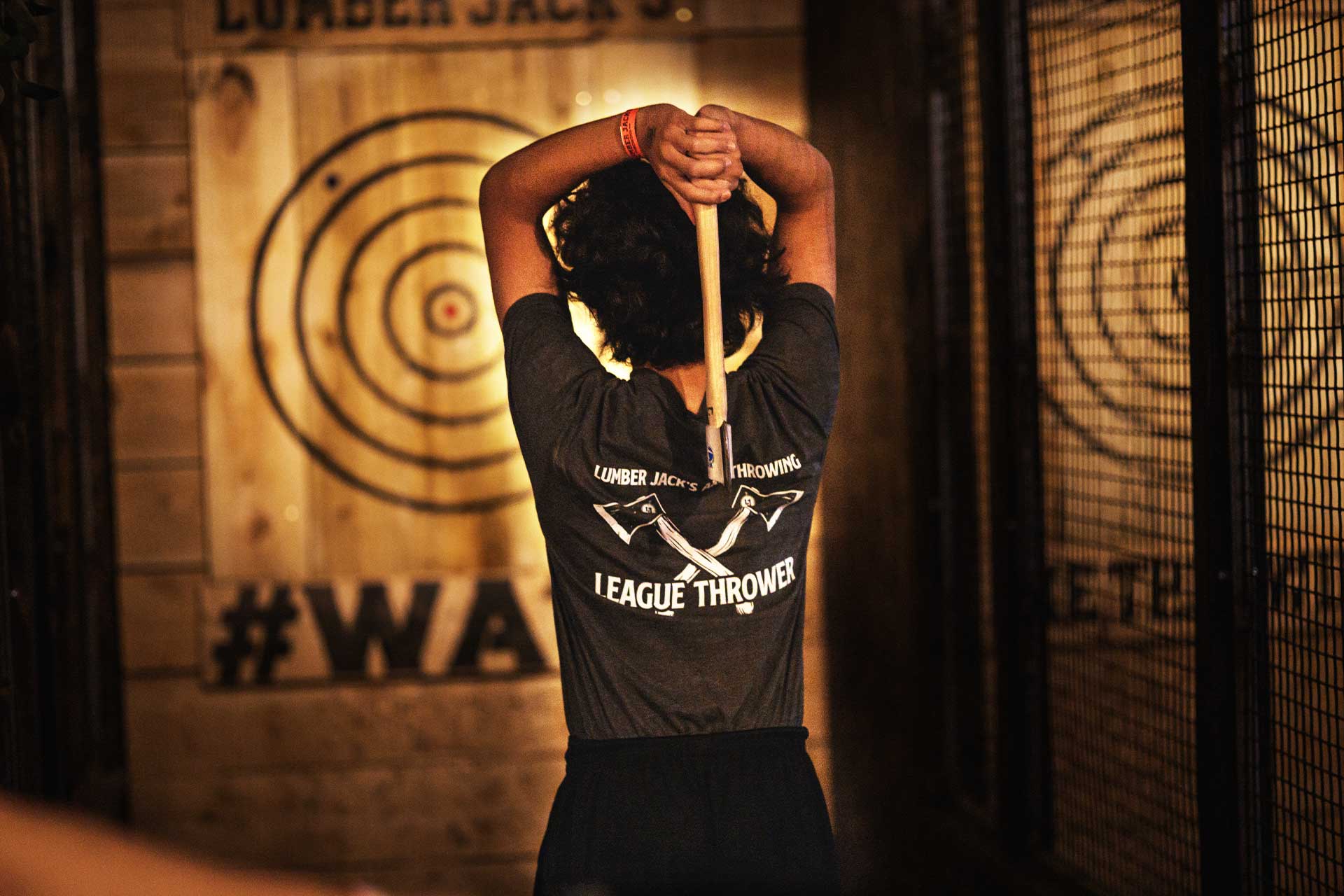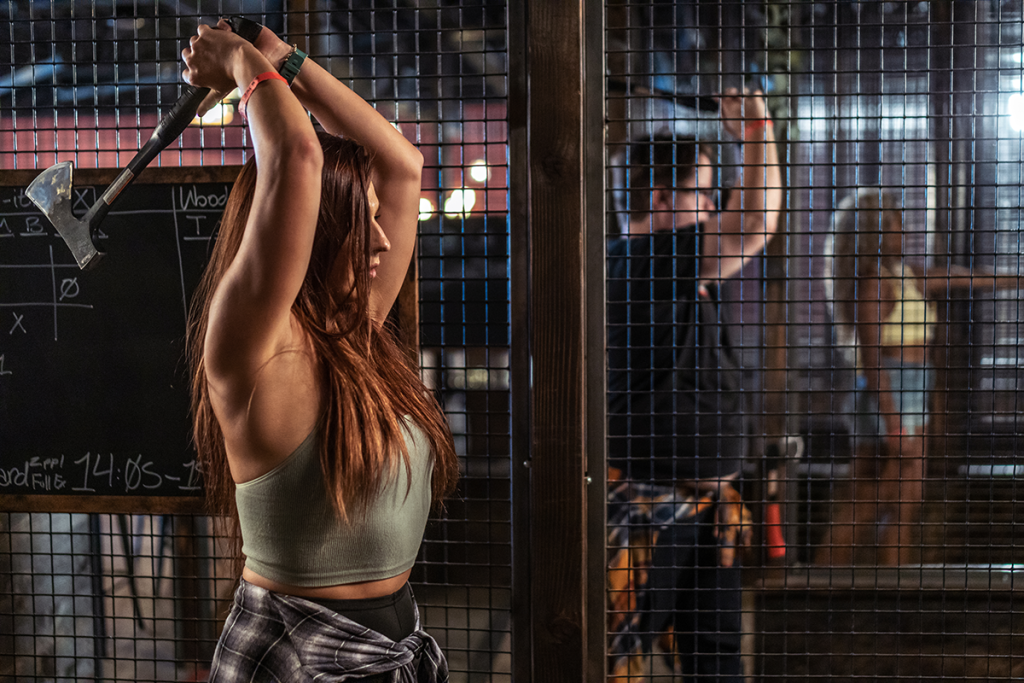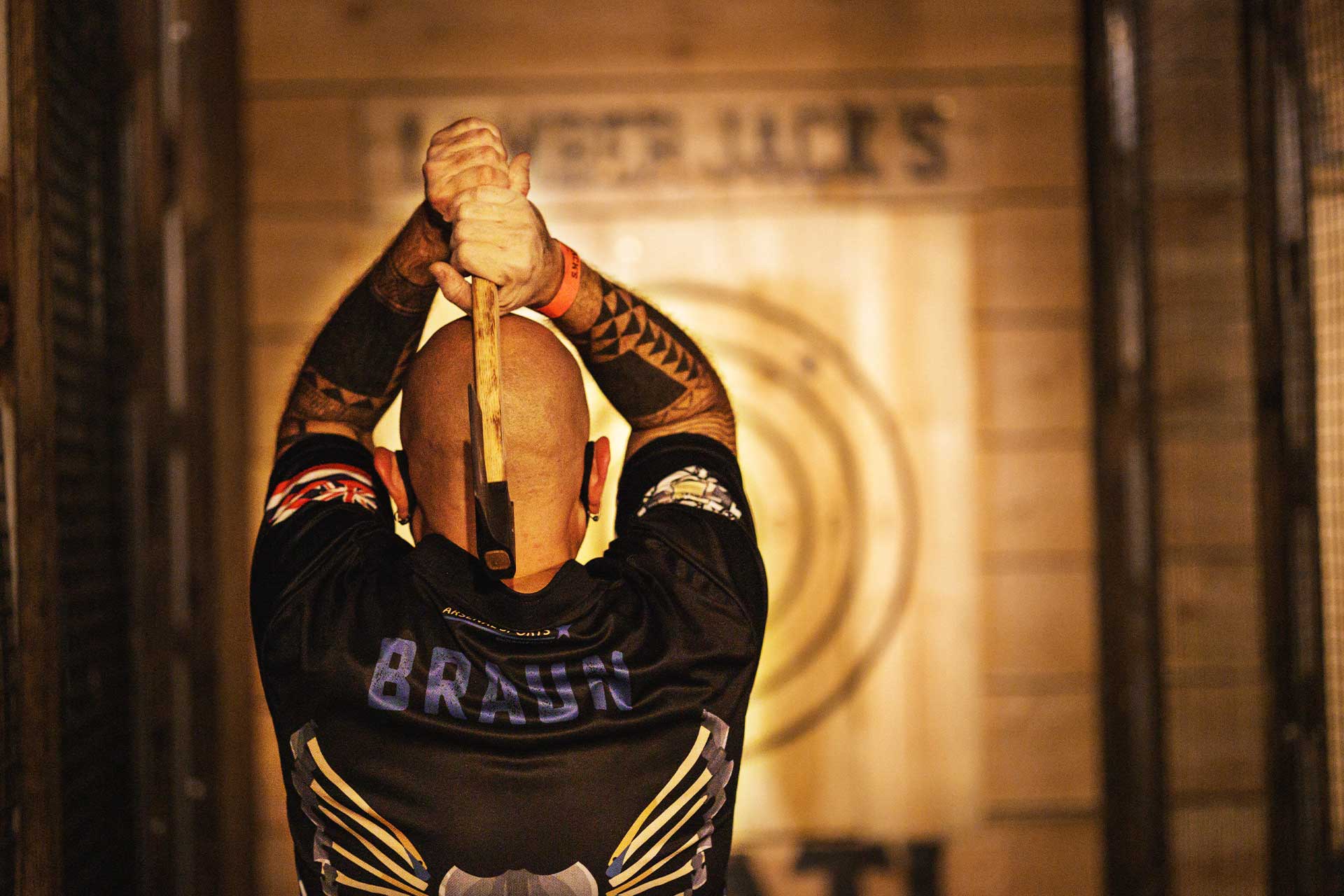Are you interested in getting started with the sport of axe throwing? Maybe you’re already skilled at throwing axes and you’re looking to sharpen your technique. At Lumber Jack’s Axe Throwing, we have a variety of resources and axe throwing tips to help you get a grip. We even have a whole blog post dedicated to learning how to throw an axe. If you’ve never thrown an axe before, start by reading our blog post!
Axe Thrower Safety Tips
Before getting started, it is important to consider safety first. Axe throwing is a sport that requires precision and skill.

Here are some safety tips from the axe perts to keep in mind:
• Always use a secure and sturdy throwing target
• Always wear closed-toe shoes and long pants
• Keep a sharp axe
• Wear protective eyewear
• Never stand directly behind or next to another thrower
• Maintain a safe distance from the target at all times
• Make sure you have a minimum of a clear six foot radius around you
• Make sure minors are supervised by an adult at all times while around axes and targets
By following these simple guidelines, you can ensure that your axe throwing experience is safe and enjoyable. Remember to always practice safety first and have fun!
Axe Throwing Stance Basic Techniques
The most important part of axe throwing is having the right axe throwing stance. You want to keep your feet shoulder-width apart with one foot slightly in front of the other. Keep your weight evenly distributed, and your back straight and even. Make sure you’re facing the target and not looking at the ground.
Grip Axe Firmly
When you’re holding the axe handle, don’t grip it too tightly. You want to maintain a light grip that allows for flexibility and movement in your wrist and arm. It’s important to keep your throwing hand relaxed so that you have an accurate throw.
Use Your Core Muscles
When you throw, make sure you are utilizing the power of your core muscles. This will help you generate the power that you need for a good throw. You should slightly rotate your body to the side with your throwing arm and use your other arm as a counterbalance.
Follow Through With Your Throw
Once you release the axe, follow through with the motion of your throwing arm even after it has left your hand. This will help you maintain accuracy and make sure the axe has enough power to reach the target.
Breathe and Focus
Take a deep breath before beginning your throw. You should take your time and focus on completing an accurate, powerful throw. Make sure you are relaxed but not too loose; if your muscles are too relaxed, it will affect your accuracy.
Practice Makes Perfect
The most important thing about axe throwing is practice and patience! Keep practicing until you develop a good technique that works for you, then start working on perfecting it. Even if it takes some time to learn how to throw an axe properly, stick with it and you’ll be a pro in no time.
No matter how much practice you put into it, make sure that safety is always your priority. Wear the appropriate clothing and always have someone nearby to help if needed. With this knowledge and a little bit of practice, you’ll be throwing axes like an expert in no time!
Once You Have Axe Throwing Experience
Once you’ve mastered the basic techniques of axe throwing, you can start to add some tricks. Experiment with different throws and see what works best for you. With enough practice, you may even find yourself competing in axe-throwing competitions!
One Handed Throw
A one-handed throwing technique is slightly more difficult but can be great for beginners as it helps build balance and strength in the core. Start by gripping the axe handle firmly with just your dominant hand, then extend it back behind you and release the axe straight at the target when ready. As with two-handed throwing, you’ll want to make sure all of the energy is coming from your core rather than relying solely on your arm.
Spin
Once you’ve got a good grip and throwing motion down, adding spin can help give you a more accurate throw. Start by spinning quickly in place before releasing the axe towards the target – this adds extra momentum to each throw. You can also practice throwing diagonally across yourself, which will force an even faster spin.
Follow-Through
Once the axe has left your hand, it’s important to follow through with the throw. This means that you’ll need to keep your arm extended in the same direction as the axe is traveling even after it’s gone. Following through helps ensure that all of your energy is transferred into the throw, giving more accuracy and power at the target. Just be sure not to overextend yourself – having good form is key!
Two Handed Throw
Once you’ve mastered the one-handed technique, it’s time to move up to a two-handed throw. The two handed technique is even more powerful than the one-handed throw and can be used for longer distance throws. To perform the two handed technique, hold the axe handle in both hands with your dominant hand on the handle and your other hand gripping around the axe head.
Swing
Then, swing back and forth as if you were swinging a baseball bat, and release the axe from your dominant hand when you are in alignment with the target. You’ll want to put some effort into the throw so that you can get maximum velocity, but you want to avoid flicking your wrists.
Follow-Through
Be sure to keep your arms extended forward and straight throughout the entire throwing motion and follow through after releasing! This will ensure that your axe is in a straight line with the desired force.
Two Handed Overhand Throw
This is the most powerful technique for throwing an axe and can be used when you need maximum distance. As with all other throws, it’s important to remember that form is key – a sloppy throw will not only result in less power but could also cause injury! To perform this technique, hold the axe with both hands and position them above your shoulder blades.
Swing
Swing back and forth, maintaining the same form as a golf swing – this creates maximum wind-up power for each axe throw. Focus on keeping your arms and torso perfectly straight, while engaging the core muscles for stability. As you swing, begin to shift your weight forward and transfer it to the axe – push out at the apex of each swing, throwing the axe as far away from you as possible!
Follow Through
Once you’ve thrown the axe, follow through for a full completion of the throw. Allow your arms to finish at the same level as your shoulder blades, with your hands remaining close together. This will generate maximum velocity and accuracy for each throw.
With a little practice and determination, you’ll be a pro at axe throwing in no time. Be sure to take frequent breaks and practice proper form and technique in order to stay safe and have a great axe throwing adventure!
For More Experienced Axe Throwers
If you’re one of the more advanced axe throwers and want to take your skills to the next level, there are plenty of competitions and league play held at Lumber Jack’s Axe Throwing that will test your accuracy, speed, and agility. We also have experienced coaches on hand to give you axe throwing tips and advice on how to improve your game, stance, or throwing technique.
There are also tournaments held regularly around the world, so if you’re an avid axe thrower who wants to get into competitive axe throwing check out The World Axe Throwing League and its events.
For more information on competitive axe throwing and league play, contact us today!
Frequently Axed Questions
Does Lumber Jack’s use a felling axe or hatch for their axe throwing?
Lumber Jack’s uses specially designed hatchets for their axe throwing experiences. These hatchets are specifically shaped and weighted to give you the best results when it comes to accuracy, speed, and distance. For a beginner, the hatchets and larger axes we offer at Lumber Jack’s are a good starting point. They also hold up well against repeated use!
Are advanced axe throwers welcome?
Absolutely! We are always excited to welcome experienced axe throwers who want to take their skills to the next level. Our experienced staff can provide tips and guidance for improving your accuracy and technique, so you can reach peak performance when it comes time for competitions.
We also host several axe-throwing tournaments throughout the year for advanced players – these events are a great way to test your skills and compete against other experienced axe throwers. No matter your level, Lumber Jack’s is the perfect destination for all of your axe-throwing needs!
How can I fix an over rotated throw?
In order to fix an over rotated throw, you can simply adjust your stance – try taking a half step closer or maybe even a few steps forward. If you’re trying to fix an under rotated throw, try taking a half step backwards and aiming slightly to the right or left.
Why does a sharp axe blade matter?
A dull axe blade can cause the axe to bounce or ricochet off of the target when the axe hits and into an unintended direction. This could lead to serious injury, so having a very sharp axe blade is incredibly important when you’re axe throwing.
Can I bring my own axe?
For safety reasons, Lumber Jack’s does not allow customers to bring their own axes or hatchets onto the premises. All of our hatchets are designed and weighted specifically for axe throwing accuracy and safety.





Leave a Reply